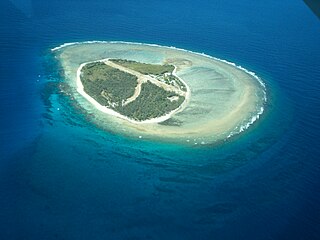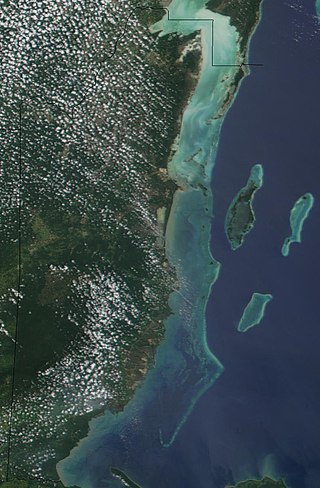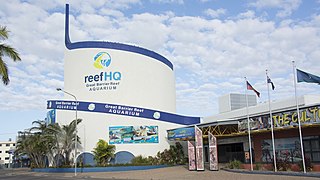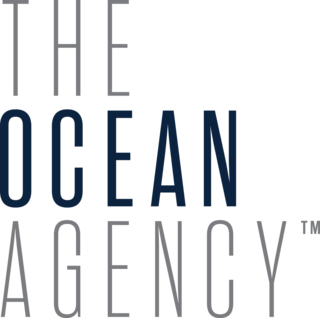Related Research Articles

The Great Barrier Reef is the world's largest coral reef system composed of over 2,900 individual reefs and 900 islands stretching for over 2,300 kilometres (1,400 mi) over an area of approximately 344,400 square kilometres (133,000 sq mi). The reef is located in the Coral Sea, off the coast of Queensland, Australia, separated from the coast by a channel 100 miles wide in places and over 200 feet deep. The Great Barrier Reef can be seen from outer space and is the world's biggest single structure made by living organisms. This reef structure is composed of and built by billions of tiny organisms, known as coral polyps. It supports a wide diversity of life and was selected as a World Heritage Site in 1981. CNN labelled it one of the Seven Natural Wonders of the World in 1997. Australian World Heritage places included it in its list in 2007. The Queensland National Trust named it a state icon of Queensland in 2006.

The Great Barrier Reef Marine Park protects a large part of Australia's Great Barrier Reef from damaging activities. It is a vast multiple-use Marine Park which supports a wide range of uses, including commercial marine tourism, fishing, ports and shipping, recreation, scientific research and Indigenous traditional use. Fishing and the removal of artefacts or wildlife is strictly regulated, and commercial shipping traffic must stick to certain specific defined shipping routes that avoid the most sensitive areas of the park. The Great Barrier Reef is the largest and best known coral reef ecosystem in the world. Its reefs, almost 3000 in total, represent about 10 per cent of all the coral reef areas in the world. It supports an amazing variety of biodiversity, providing a home to thousands of coral and other invertebrate species, bony fish, sharks, rays, marine mammals, marine turtles, sea snakes, as well as algae and other marine plants.

Capricornia Cays is both a national park and a scientific national park in Queensland (Australia), located 486 km and 472 km north of the state capital Brisbane respectively. Collectively they comprise 241 ha of coral cays.

The Coral Sea is a marginal sea of the South Pacific off the northeast coast of Australia, and classified as an interim Australian bioregion. The Coral Sea extends 2,000 kilometres (1,200 mi) down the Australian northeast coast. Most of it is protected by the French Natural Park of the Coral Sea and the Australian Coral Sea Marine Park. The sea was the location for the Battle of the Coral Sea, a major confrontation during World War II between the navies of the Empire of Japan, and the United States and Australia.

Lady Elliot Island is the southernmost coral cay of the Great Barrier Reef, Australia. The island lies 46 nautical miles north-east of Bundaberg and covers an area of approximately 45 hectares. It is part of the Capricorn and Bunker Group of islands and is owned by the Commonwealth of Australia. The island is home to a small eco resort and an airstrip, which is serviced daily by flights from Bundaberg, Hervey Bay, Brisbane and the Gold Coast.
Ron Josiah Taylor, AM was a prominent Australian shark expert, as is his widow, Valerie Taylor. They were credited with being pioneers in several areas, including being the first people to film great white sharks without the protection of a cage. Their expertise has been called upon for films such as Jaws, Orca and Sky Pirates.
Sir Charles Maurice Yonge, CBE, FRS FRSE was an English marine zoologist.

Shark tourism is a form of eco-tourism that allows people to dive with sharks in their natural environment. This benefits local shark populations by educating tourists and through funds raised by the shark tourism industry. Communities that previously relied on shark finning to make their livelihoods are able to make a larger profit from diving tours while protecting the local environment. People can get close to the sharks by free- or scuba diving or by entering the water in a protective cage for more aggressive species. Many of these dives are done by private companies and are often baited to ensure shark sightings, a practice which is highly controversial and under review in many areas.

The Belize Barrier Reef is a series of coral reefs straddling the coast of Belize, roughly 300 metres (980 ft) offshore in the north and 40 kilometres (25 mi) in the south within the country limits. The Belize Barrier Reef is a 300-kilometre (190 mi) long section of the 900-kilometre (560 mi) Mesoamerican Barrier Reef System, which is continuous from Cancún on the north-eastern tip of the Yucatán Peninsula through the Riviera Maya and down to Honduras, making it the second largest coral reef system in the world after the Great Barrier Reef in Australia. It is Belize's top tourist destination, popular for scuba diving and snorkeling and attracting almost half of its 260,000 visitors. It is also vital to the country's fishing industry.

Hol Chan Marine Reserve is a marine reserve close to Ambergris Caye and Caye Caulker, off the coast of Belize. It covers approximately 18 km² (4,448 acres) of coral reefs, seagrass beds, and mangrove forest. Hol Chan is Mayan for "little channel".

Reef HQ is the world's largest living coral reef aquarium. It is located in Townsville, Queensland, Australia. The aquarium was built as a Bicentennial Commemorative project and is a part of the Great Barrier Reef Marine Park Authority (GBRMPA). The Coral Reef Exhibit has 130 coral species and 120 fish species along with hundreds of species of sea stars, sea urchins, sea cucumbers, brittle stars, feather stars, snails, worms and sponges.

The Great Barrier Reef is the world's largest reef systems, stretching along the East coast of Australia from the northern tip down at Cape York to the town of Bundaberg, is composed of roughly 2,900 individual reefs and 940 islands and cays that stretch for 2,300 kilometres (1,616 mi) and cover an area of approximately 344,400 square kilometres (133,000 sq mi). The reef is located in the Coral Sea, off the coast of Queensland in northeast Australia. A large part of the reef is protected by the Great Barrier Reef Marine Park.

Sodwana Bay is a bay in South Africa on the KwaZulu Natal north coast, between St. Lucia and Lake Sibhayi. It is in the Sodwana Bay National Park, and the Maputaland Marine Reserve, and is a popular recreational diving destination. The term is commonly used to refer to both the marine reserve and the terrestrial park, as well as the geographical bay.

The Coral Sea Reserves Ramsar Site comprises the 17,289 km2 of oceanic island and reef habitats within the former Coringa-Herald National Nature Reserve and the former Lihou Reef National Nature Reserve in the Australian Coral Sea Islands Territory.

The Seaview SVII is an underwater camera designed by the Catlin Seaview Survey team, intended to photograph coral reefs to provide visual documentation of a reef's health. The camera is designed to be controlled by a diver in shallow waters, and is propelled at a constant slow speed by a propeller mounted near the rear of the camera. Only two SVIIs are currently in existence. The cameras were used by the Catlin Seaview Survey and Google to create Google Ocean, a means of displaying underwater images using Google's existing Street View platform.

The Catlin Seaview Survey, later renamed the XL Catlin Seaview Survey, was a major scientific expedition which commenced in September 2012, whose aim was to document the composition and health of coral reefs worldwide. Specifically, the survey aimed to "carry out a rapid assessment of the current state of coral reef systems and to make this scientific record publicly available for scientists worldwide to use". The survey was sponsored by the Catlin Group until the survey ended when the Catlin group ended sponsorship. The original team created a film, chasing coral and a new, global initiative known as 50 reefs.

Tourism is one of the major industries in the Great Barrier Reef region. Approximately five million people visit the Great Barrier Reef each year. According to the WWF, tourism of the area contributes $5.4 billion a year to the Australian economy, and employs approximately 69,000 people. Ove Hoegh-Guldberg sees the key competitive advantage of the Great Barrier Reef as opposed to other, closer, reef tourism destinations is the region's reputation as being "the most pristine coral reef on the planet". The GBRMPA states that careful management, which includes permits for camping and all commercial marine tourism within the Great Barrier Reef Marine Park, has so far ensured that tourists have a very minimal impact on the reef.

The Ocean Agency is an international nonprofit organization dedicated to marine conservation. Currently, The Ocean Agency is focused on coral reef conservation.

Valerie May Taylor AM is a conservationist, photographer and filmmaker, and an inaugural member of the diving hall-of-fame. With her husband Ron Taylor, she made documentaries about sharks, and filmed sequences for films including Jaws (1975).
The Museum of Underwater Art (MOUA) is a series of underwater art installations near Townsville, Australia. The museum aims to promote the conservation of the Great Barrier Reef. It is the only underwater art museum in the Southern Hemisphere and consists of three sculptures created by British sculptor Jason deCaires Taylor.
References
- ↑ Great Barrier Reef coral bleaching surveys 2006 (research publication no. 87). Australia: Great Barrier reef Marine Park Authority. 2006. p. 48.
- ↑ "Survey 22 - St. Crispin's reef". Surveys of the Great Barrier Reef. Catlin Seaview Survey. Archived from the original on 27 May 2014. Retrieved 27 May 2014.
- 1 2 3 "Snorkeling at St. Crispin's reef". Wavelength. Retrieved 27 May 2014.
- ↑ "St. Crispin's Reef". Transects of St. Crispins reef. Global Reef Record. Archived from the original on 27 May 2014. Retrieved 27 May 2014.
- ↑ "Location of St. Crispin's reef". Wikimapia. Archived from the original on 27 May 2014. Retrieved 27 May 2014.
- ↑ "Map of great barrier reef". Dive Maps of Australia. PADI - Professional Association of Diving Instructors. Archived from the original on 27 May 2014. Retrieved 27 May 2014.
- ↑ "2012 survey - St. Crispin's reef". Catlin Seaview Survey. Archived from the original on 31 July 2017. Retrieved 27 May 2014.
- ↑ "Major reef sites from Port Douglas". Frommers. Archived from the original on 27 May 2014. Retrieved 27 May 2014.
- ↑ Zell, len (1 May 2014). The Great Barrier Reef: A Journey Through the World's Greatest Natural Wonder. Murdoch Books. ISBN 978-1743361795.
- ↑ "Classification of reefs". Great Barrier Reef Marine Park Authority. Archived from the original on 27 May 2014. Retrieved 27 May 2014.
- ↑ https://www.mirror.co.uk/news/world-news/mystery-couple-left-behind-shark-24255681
Coordinates: 16°07′54.14″S145°48′22.46″E / 16.1317056°S 145.8062389°E
